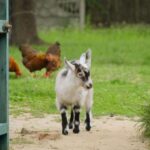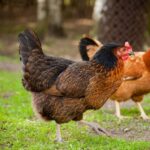There is no ‘correct' answer as to when it’s the best time to dub a rooster. Some roosters are dubbed at just a day old or while they’re young chicks. While others are dubbed after their combs and wattles have developed up to a year old.
Table of Contents
What Does Dubbing a Chicken Mean?
“Dubbing” is the term used to describe a procedure that involves removing a chicken’s comb, wattles, and sometimes their earlobes.
I’ve also heard removing wattles called ‘dewattling’ and removing combs ‘decombing’. These mean the same thing, but dubbing is the correct term used in the poultry industry.
Dubbing can be tied back to the days when cockfighting was an accepted practice. The Old English Game Fowl was one of the roosters of choice as they’re so aggressive, and they tend to go for the combs and wattles when fighting.
People started dubbing their fighting chickens to stop the bloody injuries caused by grabbing a hold of and pecking at wattles, combs, and earlobes while fighting.
How Is a Chicken Dubbed?
To perform a dubbing, the organ being removed is first disinfected. An anesthetic is then applied, and the tissues are simply cut off.
The area is disinfected and a chemical is applied to limit the bleeding. No bandages are typically used, and it’s fairly quick to heal over.
Obviously, this is a procedure best performed by a vet or an animal care professional with experience carrying out this procedure.
When Is the Best Time to Dub a Rooster?
This is a tough question to answer. It’s going to come down to what breed of rooster you have, and the reason why you want to have them dubbed.
One thing to be aware of is that it gets more difficult the longer you wait. It’s not recommended you dub a rooster older than a year, as their comb and wattle are pretty tough at that point and become harder to remove.
I reached out to a couple of friends involved in showing roosters, and they told me they typically don’t dub males older than 8 months.
They also added that the comb can more easily be removed than the wattles at an early age. Wattles usually take a little longer to develop to the point where they can be removed. FOr this reason, you might wait if you’re going to remove both the wattles and comb.
Assuming that you’re going to get an avian vet to perform the procedure, I’d reach out and ask them what they advise as they’ll likely have some first-hand experience.
Related - Did you know rooster combs (called cockscombs) are eaten in some parts of the world?
Why Are Chickens Dubbed?
There are a few reasons why chickens are dubbed, these are:
To Prevent Frostbite
Frostbite is a serious issue for chickens in the winter months, especially if they have large combs.
Dubbing is often used as a preventative measure as frostbite can cause some serious damage. If a chicken does get frostbite, the extremities of its comb will turn black and potentially drop off.
It’s In a Chicken's Best Interest
Sometimes dubbing is in the best interests of a chicken’s health.
Typical examples are a huge comb that is causing them to struggle to eat properly as it weighs too much, getting pecked at a lot, or causing some other issues, it can be removed.
In the Commercial Setting
In commercial settings where they are a lot of chickens in a small space, pecking and fighting are more prevalent.
Chickens like to peck at each other’s combs and wattles when fighting. Removing them doesn’t help the overall issue of fighting, but it’s commonly done to help a little.
Aesthetic Purposes for Show Chickens
This is the most controversial reason, but dubbing is still done for show chickens. Most of the animal rights groups and organizations that look out for animal welfare disagree with it, for obvious reasons.
I know that the RSPCA in Australia has been outspoken about opposing dubbing for show purposes. As has the Farm Animal Welfare Council in the UK, to mention just two.
Does Dubbing Hurt a Chicken?
Dubbing does cause pain. Just think, would it hurt you if you had some flesh containing blood vessels and nerve endings cut off?
It would, and you certainly wouldn’t want it done for cosmetic reasons (OK, I’m aware that there are some cosmetic procedures that do exactly that).
I know there are different “rules” and circumstances surrounding animals when it comes to such procedures. But I think you get my point.
A vet would use some anesthetic to ensure it’s as painless and as stress-free as possible. If you were thinking about doing it yourself, please don’t attempt it without anesthetizing and knowing exactly what you’re doing.
Related - Do all chickens have combs?
In Summary
Now you know what dubbing is in the poultry world; dubbing is the process of removing a chicken’s wattles, comb, and earlobes.
So, if you’ve ever seen a chicken without a comb or wattles, it probably means they have been dubbed for some reason.
Keep in mind that it’s not always just for appearances, sometimes it’s necessary for health reasons. But please remember, chickens have feelings, too, you know.
Resources
Image credits - Header photo by paulo morales on Unsplash
RSPCA’s stance on dubbing for poultry shows - RSPCA.org.au




